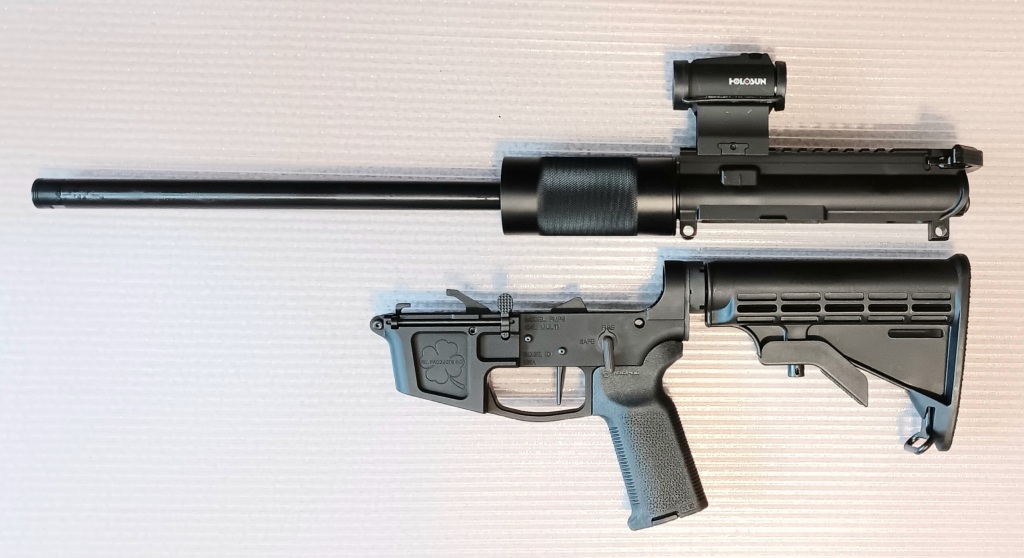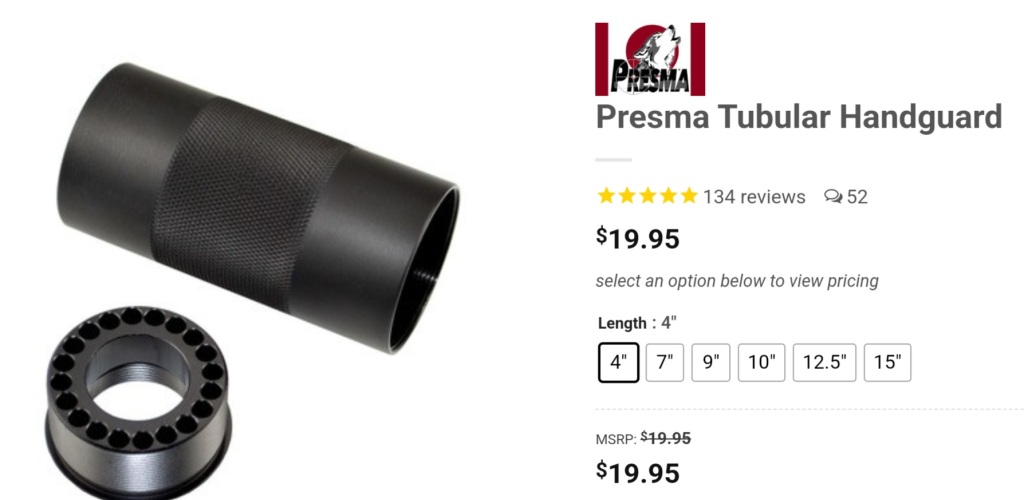Is making a 9mm AR into a “takedown model” easier than everyone thinks it is? Takedown models allow a rifle to be stored and transported in a very small package. Here’s my 16″ 9mm AR takedown upper, and how it works.
This information is intended solely for entertainment purposes only. Do not perform any action based on any of the following information. The accuracy of this information is not guaranteed or warranted. Always bring malfunctioning firearms to a qualified gunsmith for repair. All copyrights and trademarks are the property of their respective owners. I am not a lawyer. This is not legal advice. Consult an attorney for any and all legal matters. Always follow and perform all manufacturer safety and testing procedures.

A traditional “takedown” model of a firearm is one where the barrel can be easily removed from the action for storage and transport. Some examples include the .22LR Henry AR-7, which fits into it’s own stock, the Ruger PC Carbine, the TNW Aero Survival Rifle, and the JRC Takedown. But can we do this with a standard 9mm AR receiver set?
Prefer a video? Here you go!
I know the first objection I’ll hear is something along the lines of “The AR platform is already a takedown gun – just separate the two halves of the receiver!”.
Well…. yes and no.
If we separate a 16″ barreled upper receiver from the lower receiver, we’re left with a 23″ long upper/barrel assembly that needs to be stored.

What if we could just remove the barrel? With the barrel removed, the stock/buffer tube/receivers are only about 15.5″ long, and the barrel 16″ long. This means that the entire package fits into a much smaller carrying case.

Removing the barrel from a 9mm AR receiver set poses two potential problems. Headspacing, and barrel nut torque/handguard alignment.
Headspacing
The good news is that a 9mm simple blowback firearm headspaces on the cartridge case mouth. As long as the barrel chamber is machined at the correct depth and the barrel is properly installed and tight in the receiver, headspacing is a non-issue.
Barrel nut torque/handguard alignment
AR armorers follow a specific process to properly torque the barrel nut. This torque helps prevent the barrel nut from unscrewing by itself, which would twist the handguard around the barrel. The handguard needs to be aligned properly so the top rail lines up with the upper receiver rail. In gas operated AR-15’s, this is also important because a gas tube may need to go though, or align with, the barrel nut. If the handguard or nut moves, it could damage the gas tube, rendering the rifle unusable.
9mm blowback doesn’t use a gas tube, so that’s not a concern.
So then, what if we use a handguard that doesn’t need to be aligned in a certain orientation? If we are planning on frequently removing the handguard and barrel nut to remove the barrel, is a high level of torque even necessary?
Enter the Presma tubular handguard…
Presma makes 4″, 7″, 9″, 10″ 12.5″ and 15″ tubular handguards that come with a round barrel nut, ranging in price from $20 – $35 (at the time of this writing).

The barrel nut is designed to be attached to the receiver with an armorer’s wrench, and the tubular handguard is then screwed on to the barrel nut. But what if we attach the barrel nut to the handguard FIRST (red Loctite will make it semi-permanent), then use the handguard as a tool to grip the barrel nut and screw it firmly onto the receiver, hand-tight?
Well, it works like a charm! The handguard/barrel nut assembly simply acts like an oversized barrel nut. It can be attached and removed easily.
With this setup I can easily unscrew the barrel nut/handguard, remove the barrel, and store/transport my 9mm AR in a very small package. Simply re-attaching the barrel and firmly tighening the barrel nut/handguard by hand puts the gun back into action.
BTW, I’ve found that it is not necessary to lock the bolt back when assembling or disassembling.
Another big advantage of building an upper with this barrel nut/handguard is that it does not require a vice, upper vice block, torque wrench, and crows-foot wrench to assemble the upper. It can be completely assembled by hand in 2 minutes, straight out of the shipping box. The only thing I needed was some Red Loctite to semi-permanently lock the barrel nut to the handguard.
What about accuracy/repeatability?
Here’s a target. Shots were taken freestanding about 15 yards away. The optic was not sighted in. I just attached it to the upper receiver rail and took the shots. (I swap optics on this upper for testing.)

First, I attached the barrel and optic at the range and fired 5 shots. Then I took the barrel off, reattached it, and fired 5 more shots. I did not sight-in this optic at all, so it was shooting a little low/right, but you can see that both groups were in the same area relative to the aiming point (the red dot). It is very consistent despite being taken apart and reassembled.
My 16″ barrel has a locator pin (some 9mm barrels don’t), so repeatability of the barrel installation is very good. If I were to use a barrel without a locator pin, I’d mark the barrel to make sure it’s always assembled in the same orientation.
What about safety?
I have not had any sort of issue using this setup and I can’t think of any reason why there should be any problems as long as the barrel is installed properly and the handguard/barrel nut are kept firmly tightened. I check the barrel nut for tightness throughout each shooting session, and I’ve never had it loosen.
Other takedown systems work exactly the same way. A combination barrel nut/handguard is hand-tightened to keep the barrel in place.
Unscrewing the handguard seems slow. Aren’t there faster ways to make a 9mm rifle smaller?
Yes, it does take about a minute to put it together. Takedown models aren’t designed to be fast, they’re designed to be compact for storage and transport.
There are faster systems for assembly/disassembly out there, and there are other ways to make the 9mm AR more compact. The Ruger Takedown system uses about a 1/4 turn of the barrel to pop it off. The Dolos system for the AR platform can do something similar, but they’re expensive ($185). The Law Tactical folding system allows the buffer tube to fold, making the whole thing smaller, but again, they’re expensive ($220). The RAB-AD is a twist-detach system ($140) for the buffer tube. There are also micro buffer tubes, but their buffer/spring systems are usually underweight and oversprung for 9mm.
At only about $19 for the 4″ Presma tube handguard, it may be a little slower, but it’s very inexpensive and seems to work extremely well.
Can I use this setup to quickly swap barrels?
It depends. I am not a lawyer and this is not legal advice. Swapping barrel lengths in the U.S. can be a little tricky.
It is my understanding that in the U.S. (again, I am not a lawyer, this is not legal advice!):
If the serialized receiver was sold as a “Handgun” or, if it was sold as a “Other Firearm” (bare receiver) and it is assembled for the first time with no stock and a barrel shorter than 16 inches (thereby making it into a “Handgun” receiver), then it is OK to switch barrels to any length at all, and when assembled with a barrel 16″ or longer (per US v. Thompson-Center), a stock can be used.
If the serialized receiver was sold as a “Long Gun”, or it was sold as a “Other Firearm” (bare receiver) and it is assembled for the first time with a stock attached and a 16 inch or longer barrel (thereby making it into a “Long Gun” receiver), then only barrels 16 inches or longer can be used.
Assembling a serialized receiver with a stock attached and a shorter than 16 inch barrel can be prosecuted as a felony unless the serialized receiver is first registered as a “Short Barreled Rifle” and the appropriate federal tax is paid.
Ask a lawyer to be sure, and always follow all applicable laws.
Conclusions/pricing:
I like this setup! It’s relatively quick to take apart and put together, it’s shrinks to a very small package, and the accuracy remains very good despite completely removing and reattaching the barrel.
I see this as a great option for hiking, ATV carry, general transport, storage in small living spaces, or for securing in smaller locking cases.
Checking the prices, the parts for a takedown upper like this one should only cost about $295 before shipping/tax – including bolt and charging handle, minus optic. (Parts priced through BKingsFirearms.com and AR15Discounts.com, May 2024.)

